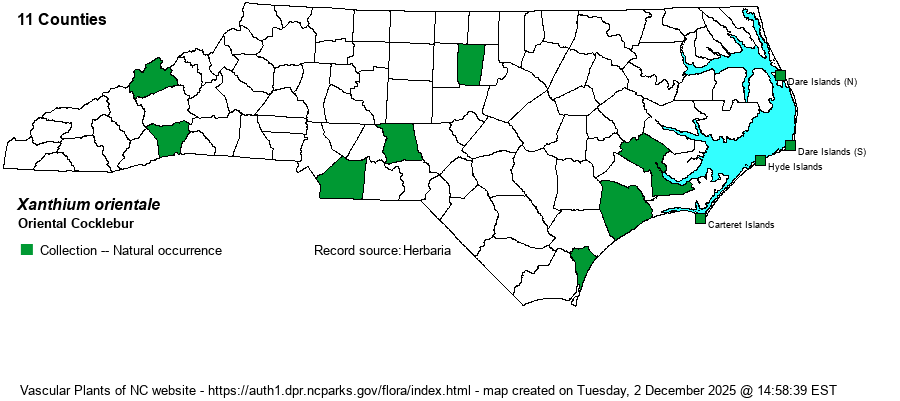| Author | L. | |
| Distribution | Mostly outer Coastal Plain and Outer Banks; scattered records inland. Apparently sparse on the landscape and with large gaps between occurrences. However, it is assumed that few biologists/botanists bother to collect specimens of cockleburs, and thus the distribution is poorly known. For example, the inland distribution through specimens, as shown on the map below, is certainly not biologically realistic for a native species.
Widespread in North America, where it is assumed to be native. | |
| Abundance | Seemingly uncommon to fairly common along much of the coast, at least on the Outer Banks and a few other coastal islands. Probably quite rare farther inland. | |
| Habitat | Maritime dunes and beaches, sandy river shores (French Broad River, Madison County), fallow fields, pastures, clearings, agricultural crop fields, ballast, waste lots. If truly native, then this species is one of the most weedy in our flora -- and it is grossly undercollected! (A species -- native or not -- that grows in these ruderal habitats listed above, cannot be rare away from the coast.) | |
| Phenology | Flowering and fruiting August-October. | |
| Identification | Oriental Cocklebur is readily identified by its 3 cm long (or so), elliptical, dark brown fruits that are beset with hooked prickles. The bases of the prickles, and body of the bur, are moderately to densely covered with short glandular hairs, sometimes mixed with non-glandular hairs -- making the burs sticky to the touch. Plants usually sprawl on other vegetation, and stem and branches may grow as much as 6 feet, but usually half that or less. The leaves are fairly large and triangular to strongly 3-5 lobed, like a grape (Vitis) or maple (Acer). Common Cocklebur is very similar, but differs in having tan or light brown burs with few or no glandular hairs, and smaller burs (up to 2 cm vs. maximum of 3 cm in X. orientale). | |
| Taxonomic Comments | See revised nomenclature of this genus in Weakley (2018). NOTE: Plants of the Outer Banks are nearly all Oriental Cocklebur; none of them appear to be the maritime X. echinatum, which Weakley says ranges south to VA.
| |
| Other Common Name(s) | Glandular Cocklebur | |
| State Rank | [S3?] | |
| Global Rank | G5T5 [G5] | |
| State Status | | |
| US Status | | |
| USACE-agcp | | |
| USACE-emp | | |

